Part of a series of articles titled Park Air Profiles.
Article
Park Air Profiles - Yosemite National Park
Air Quality at Yosemite National Park
Most visitors expect clean air and clear views in parks. However, Yosemite National Park (NP), California, experiences some of the worst air pollution of any national park in the U.S. The park is downwind of many air pollution sources, including agriculture, industry, major highways, and urban pollutants from as far away as the San Francisco Bay Area. Air pollutants blown into the park can harm natural and scenic resources such as soils, surface waters, plants, wildlife, and visibility. The National Park Service works to address air pollution effects at Yosemite NP, and in parks across the U.S., through science, policy and planning, and by doing our part.
Nitrogen and Sulfur
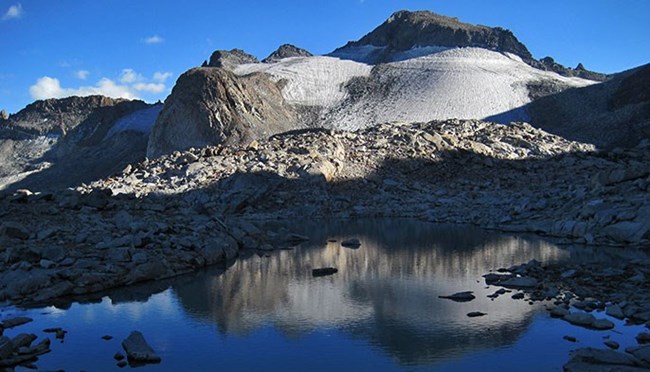
Nitrogen (N) and sulfur (S) compounds deposited from the air may have harmful effects on ecosystem processes. Healthy ecosystems can naturally buffer a certain amount of pollution, but once a threshold is passed the ecosystem may respond negatively. This threshold is the critical load, or the amount of pollution above which harmful changes in sensitive ecosystems occur (Porter 2005). N and S deposition change ecosystems through eutrophication (N deposition) and acidification (N + S deposition). Eutrophication increases soil and water nutrients which causes some species to grow more quickly and changes community composition. Ecosystem sensitivity to nutrient N enrichment at Yosemite National Park (YOSE) relative to other national parks is very high (Sullivan et al. 2016); for a full list of N sensitive ecosystem components, see: NPS ARD 2019. Acidification leaches important cations from soils, lakes, ponds, and streams which decreases habitat quality. Ecosystem sensitivity to acidification at YOSE relative to other national parks is very high (Sullivan et al. 2016); to search for acid-sensitive plant species, see: NPSpecies.
From 2017-2019 total N deposition in YOSE ranged from 4.6 to 6.8 kg-N ha-1 yr-1 and total S deposition ranged from 0.4 to 1.4 kg-S ha-1 yr-1 based on the TDep model (NADP, 2018). YOSE has been monitoring atmospheric N and S deposition since 1981, see the conditions and trends website for park-specific information.
Sources of N in YOSE include agriculture and vehicle emissions from California’s Central Valley and San Francisco Bay Area.
Alpine ecosystem effects
Alpine environments are particularly vulnerable to large inputs of reactive nitrogen because of the sparse cover of vegetation, short growing seasons, large areas of exposed bedrock and talus, and snowmelt nutrient releases (Williams et al., 1996; Nanus et al., 2012). Approximately 30% of the land area in YOSE is alpine (~328 km2 above 1550 m). McClung et al. (2021) compared the 2015 estimated total N deposition (TDep; NADP, 2018) to the critical load of N for an increase in alpine sedge growth (alpine plant critical load = 3 kg-N ha-1yr-1) and the critical load of N for alpine soil nitrate leaching (alpine soil critical load = 10 kg-N ha-1yr-1; Bowman et al., 2012). They found that deposition exceeded the alpine plant critical load in 100% of the park’s alpine area, but was below the alpine soil critical load throughout the park’s entire alpine area.
Epiphytic macrolichen community responses
Epiphytic macrolichens grow on tree trunks, branches, and boles. Since these lichens grow above the ground, they obtain all their nutrients directly from precipitation and the air. Many epiphytic lichen species have narrow environmental niches and are extremely sensitive to changes in air pollution. Geiser et al. (2019) used a U.S. Forest Service national survey to develop critical loads of nitrogen (N) and critical loads of sulfur (S) to prevent more than a 20% decline in four lichen community metrics: total species richness, pollution sensitive species richness, forage lichen abundance, and cyanolichen abundance.
McCoy et al. (2021) used forested area from the National Land Cover Database to estimate the impact of air pollution on epiphytic lichen communities. Forested area makes up 1436 km2 (47.6%) of the land area of Yosemite National Park.
- N deposition exceeded the 3.1 kg-N ha-1 yr-1 critical load to protect N-sensitive lichen species richness in 100% of the forested area.
- S deposition was below the 2.7 kg-S ha-1 yr-1 critical load to protect S-sensitive lichen species richness in every part of the forested area.
For exceedances of other lichen metrics and the predicted decline of lichen communities see Appendices A and B of McCoy et al. (2021).
Additional modeling was done on 459 lichen species to test the combined effects of air pollution and climate gradients (Geiser et al. 2021). A critical load indicative of initial shifts from pollution-sensitive toward pollution-tolerant species occurred at 1.5 kg-N ha-1 yr-1 and 2.7 kg-S ha-1 yr-1 even under changing climate regimes.
Plant species response
Plants vary in their tolerance of eutrophication and acidification, and some plant species respond to nitrogen (N) or sulfur (S) pollution with declines in growth, survival, or abundance on the landscape. Horn et al. (2018) used the U.S. Forest Service national forest survey to develop critical loads of N and critical loads of S to prevent declines in growth or survival of sensitive tree species. Clark et al. (2019) used a database of plant community surveys to develop critical loads of N and critical loads of S to prevent a decline in abundance of sensitive herbaceous plant species. According to NPSpecies, Yosemite National Park contains:
- 6 N-sensitive tree species and 22 N-sensitive herbaceous species.
- 7 S-sensitive tree species and 18 S-sensitive herbaceous species.
Mycorrhizal community response
Many plants have a symbiotic relationship with mycorrhizal fungi (MF). Through the roots, the plants supply the fungi with carbon from photosynthesis and in exchange the MF enhance nutrient availability within soils, increase drought tolerance, and provide physical resistance to soil erosion (George et al., 1995; Cheng et al., 2021; Burri et al., 2013). Anthropogenic Nitrogen (N) deposition can disrupt this symbiotic relationship resulting in a shift from N sensitive to N tolerant mycorrhizal fungi and plant communities.
With increased N deposition to the soil, MF become less important for nutrient uptake and many plants will cease the exchange of nutrients altogether making them more vulnerable to stressors such as drought (Lilleskov et al., 2019). The CL-N for the shift in mycorrhizal community is 5-6 kg-N ha-1 yr-1 in coniferous forests and 10-20 kg-N ha-1 yr-1 broadleaf forests.
Yosemite National Park has 2030.1 km2 of coniferous forests, 0.1 km2 of broadleaf forests, and 1 km2 of mixed forests. Using the range in critical loads above, the minimum CL is exceeded in 73.3% of forested area and the maximum CL is exceeded in % of forested area based on 2019-2021 TDep Total N deposition.
Change in N and S deposition from 2000 to 2021
The maps below show how the spatial distribution of estimated Total N and Total S deposition in YOSE has changed from 2000-2002 to 2019-2021 (TDep MMF version 2022.02). Slide the arrows in the middle of the image up and down to compare N and S deposition between the two years (Yearly Data).
- Minimum N deposition decreased from 3.4 to 3.1 kg-N ha-1 yr-1 and maximum N deposition decreased from 10.1 to 9.5 kg-N ha-1 yr-1.
- Minimum S deposition decreased from 0.7 to 0.6 kg-S ha-1 yr-1 and maximum S deposition decreased from 1.5 to 1.0 kg-S ha-1 yr-1.
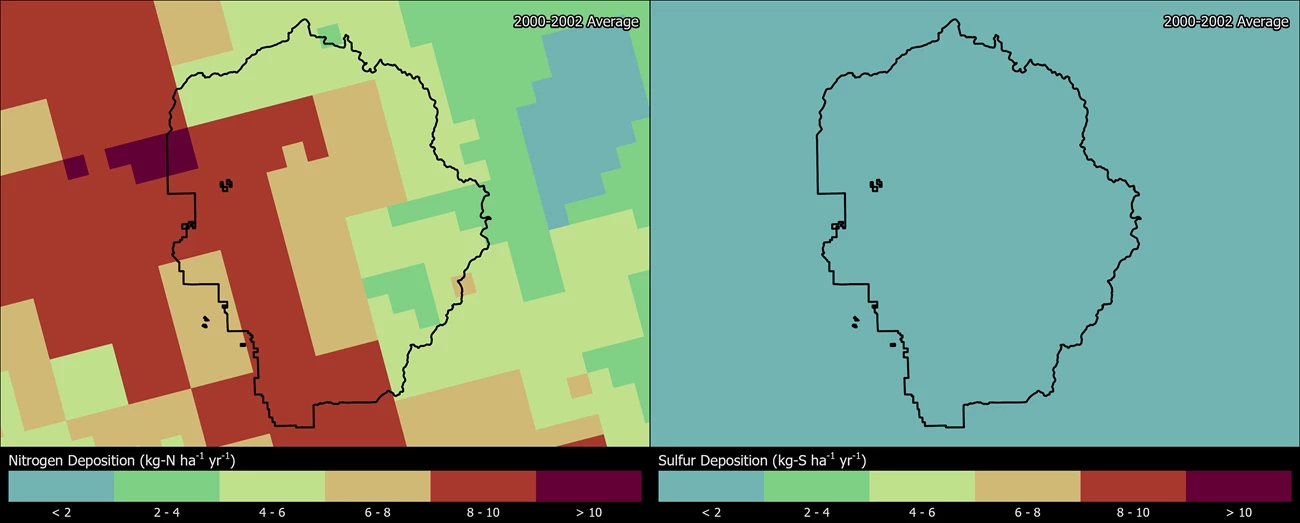
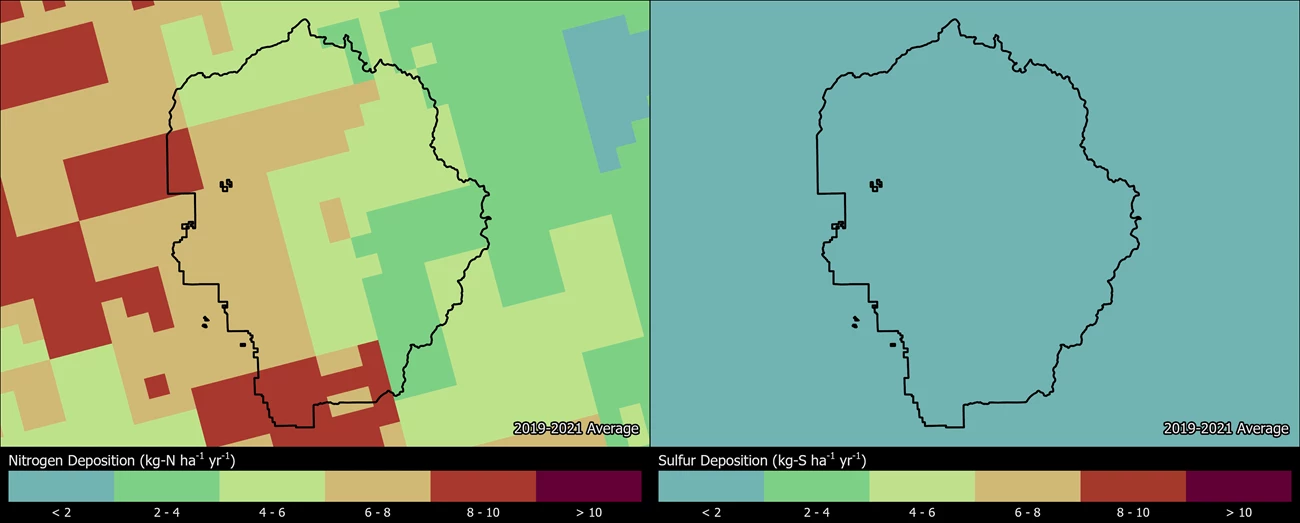
Persistent Pollutants
Pollutants like mercury and pesticides are concerning because they are persistent and toxic in the environment. These contaminants can travel in the air thousands of miles away from the source of pollution, even depositing in protected places like national parks. In addition, while some of these harmful pollutants may be banned from use, historically contaminated sites continue to endure negative environmental consequences.
When deposited, airborne mercury and other toxic air contaminants are known to harm wildlife like birds and fish, and cause human health concerns. Many of these substances enter the food chain and accumulate in the tissue of organisms causing reduced reproductive success, impaired growth and development, and decreased survival.
- Mercury concentrations in some fish sampled at Yosemite NP exceeded the thresholds for fish toxicity, bird toxicity, and human consumption. Fish were sampled and analyzed for mercury from two sites at the park and compared to data across 21 western parks. The average fish mercury concentration (82.1 ng/g ww) at the park was slightly higher than the study-wide mean (77.7 ng/g ww). Mercury concentrations exceeded the thresholds for fish toxicity, bird toxicity, and US EPA’s human consumption guidance in 7%, 27%, and 7% of fish sampled, respectively (Eagles-Smith et al. 2014).
- Another study at 14 sites in the park found mercury concentrations exceeded the thresholds for fish toxicity, bird toxicity, and human consumption in 8%, 20%, and 8% of fish sampled, respectively (Flanagan Pritz et al. 2016). Elevated concentrations of mercury were also found in fish from Hetch Hetchy Reservoir (Davis et al. 2009). However, the data may not reflect the risk at other unsampled locations in the park. Fish consumption advisories may be in effect for mercury and other contaminants (NPS 2022).
- One out of 42 male fish sampled from the park were found to be intersex (Schreck and Kent 2013). Reproductive abnormalities such as intersex, the presence of both male and female reproductive structures in the same fish, can signify exposure to contaminants.
- Some dragonfly larvae sampled at Yosemite NP had mercury concentrations at moderate impairment levels. Dragonfly larvae have been sampled and analyzed for mercury from 11 sites in the park; 40% of the data fall into the moderate (100-300 ng/g dw) impairment category for potential mercury risk. An index of moderate impairment or higher suggests some fish may exceed the US EPA benchmark for protection of human health (Eagles-Smith et al. 2018; Eagles-Smith et al. 2020).
- Mercury was found in songbird blood samples from the park, although overall songbird blood mercury levels at Yosemite NP were on average lower than established effect levels (0.35 ppm) (Adams et al. 2013).
- Pesticide concentrations in some park fish exceeded the threshold established for human health. Concentrations of dieldrin and p,p’-DDE (a degradation product of DDT often found in fish) exceeded the fish consumption threshold established for human health in 30% and 50% of fish sampled, respectively, and current-use pesticides were elevated in the Sierra Nevada – likely due to the proximity to agricultural and industrial sources (Flanagan Pritz et al. 2014).
- Older studies also found elevated concentrations of pesticides in park vegetation samples (Landers et al. 2008; Landers et al. 2010). In addition, dramatic population declines of several frog species, including the endangered mountain yellow-legged frogs, are likely linked to pesticides (Sparling et al. 2001; Fellers et al. 2004; Davidson and Knapp 2007; Flanagan Pritz 2009; Davidson et al. 2012; Smalling et al. 2013).
- Pesticides toxic to fish and bees and most likely to drift into park boundaries due to application in the counties surrounding Yosemite NP are herbicides like Oxyfluorfen, Penoxsulam, and Paraquat Dichloride (Meyer and DeMars 2018).
Visibility
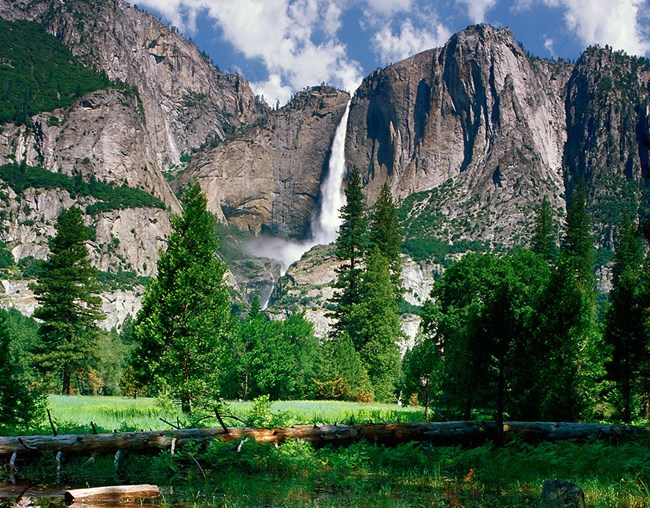
Many visitors come to Yosemite NP to enjoy world-class views of famous landmarks like El Capitán and Yosemite Falls. Unfortunately, park vistas are often obscured by haze, reducing how well and how far people can see. Visibility reducing haze is caused by tiny particles in the air (see particulate matter below). Many of the same pollutants that ultimately fall out as nitrogen and sulfur deposition contribute to this haze. Organic compounds, soot, dust, and wood smoke reduce visibility as well.
At Yosemite NP, most of the haziest days are caused by wildfire smoke. Forests in a dry Mediterranean climate like that of the Sierra Nevada are fire adapted and rely on fire as part of the ecology that sustains their health. Unfortunately, 100 years of fire suppression has left much of the lower elevation areas around Yosemite NP overgrown. As a result, occasional, but sometimes significant, smoke events are likely to occur along with wildland and prescribed fires into the foreseeable future.
It is important to note that significant improvements in park visibility on the clearest days have been documented since the late 1980’s. The clearest and mid-range visibility days in California and around the country are benefiting from clean air regulations and modern pollution control technology. Still, visibility in the park is a long way from the Clean Air Act goal of no human caused impairment.
Visibility effects:
- Reduction of the average natural visual range from about 160 miles (without the effects of pollution) to about 110 miles because of pollution at the parks;
- Reduction of the visual range from about 115 miles to below 55 miles on high pollution days.
Visit the NPS air quality conditions and trends website for park-specific visibility information. Yosemite NP has been monitoring visibility since 1988. View a live air quality webcam, and explore air monitoring »
Ground-Level Ozone
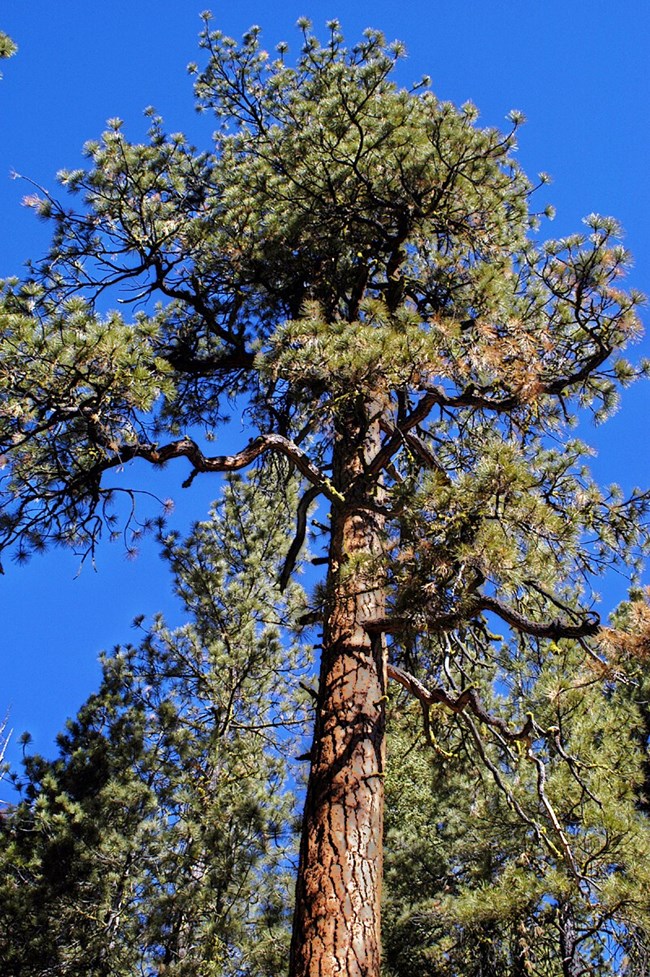
At ground level, ozone is harmful to human health and the environment. Ground-level ozone does not come directly from smokestacks or vehicles, but instead is formed when other pollutants, mainly nitrogen oxides and volatile organic compounds, react in the presence of sunlight.
During the summer months, ozone levels in the park sometimes exceed the National Ambient Air Quality Standards set by the U.S. Environmental Protection Agency to protect public health. Ozone is a respiratory irritant, causing coughing, sinus inflammation, chest pains, scratchy throat, lung damage, and reduced immune system functions. Children, the elderly, people with existing health problems, and active adults are most vulnerable. When ozone levels exceed, or are predicted to exceed, health standards, Yosemite NP staff post health advisories cautioning staff and visitors of the potential health risks associated with exposures to elevated levels.
In addition to harming human health, over the course of a growing season, ozone can damage the leaves of plants, reducing their growth rate and making them less resistant to disease and insect infestations. Some plants are more sensitive to ozone than others. Search ozone-sensitive plant species found at Yosemite NP.
Ozone Effects:
- Widespread injury to ponderosa pine needles, with up to 30–40% of pines injured at certain survey sites (Peterson et al. 1991; Peterson and Arbaugh 1992; Arbaugh et al. 1998);
- Reduced growth of ozone-injured pines (Peterson et al. 1991; Peterson and Arbaugh 1992);
- Greater ozone injury on low elevation ponderosa pines as compared to ponderosa pines on dry, upslope areas in the park, suggesting increased ozone damage on trees in moist areas (Panek and Ustin 2004).
Visit the NPS air quality conditions and trends website for park-specific ozone information. Yosemite NP has been monitoring ozone since 1976. View live ozone and meteorology data and explore air monitoring »
Particulate Matter
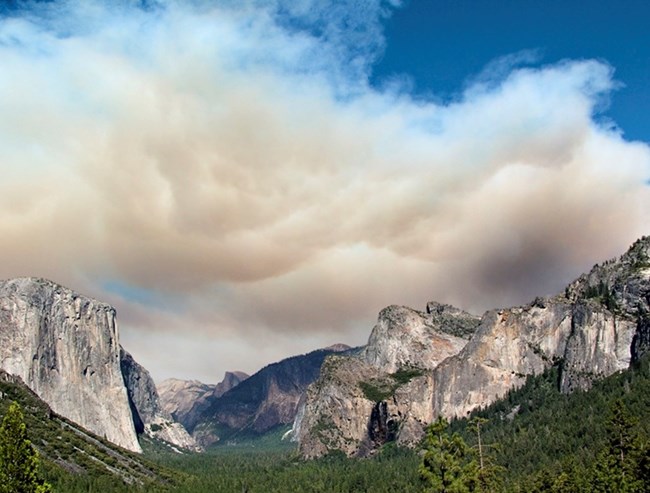
Concentrations of fine particles in the air at Yosemite NP sometimes exceed the National Ambient Air Quality Standards set by the U.S. Environmental Protection Agency to protect human health. Fine particles (smaller than 2.5 microns) originate from either direct emissions by a source, such as construction sites, power plants, and fires, or reactions with gases and aerosols in the atmosphere emitted from pollution sources upwind. An aerosol is a gaseous suspension of fine solid or liquid particles.
Because of their small size, fine particles can get deep into the lungs and cause serious health problems. Numerous scientific studies have linked particle pollution exposure to irritation of the airways, coughing, difficulty breathing, aggravated asthma, chronic bronchitis, heart attacks, and premature death in people with heart or lung disease.
The Yosemite Aerosol Characterization Study (YACS) was a field campaign conducted in 2002 to investigate visibility-impairing aerosols at the park. Determining the content of those particles allows researchers to examine sources of aerosols. A key finding of this study was that fine particles in the park primarily originate from fires. Fine particles can also come from other sources including power plants, vehicle exhaust, agriculture, and construction sites.
Smoke can collect in canyon bottoms like Yosemite Valley, as a result these areas commonly experience the highest fine particle levels when winds are calm or inversion weather patterns occur during smoke events. A stationary air quality monitor at the Yosemite Valley Visitor Center measures fine particles to identify potential health impacts from smoke and fire. As needed, Yosemite NP can also send out three mobile monitors to smoke-sensitive areas. Together, these measurements ensure that the impacts of fire on air quality in Yosemite NP are understood and quantified. Visit Smoke in Yosemite and the park’s Air Quality and Smoke Monitoring web pages to learn more and for current smoke information.
Yosemite NP has been monitoring particulate matter since 2002. Check out the most recent particulate matter levels on our live data site and explore air monitoring »
Explore Other Park Air Profiles
There are 47 other Park Air Profiles covering parks across the United States and its territories.
References
Adams, E., A.K. Jackson and D.C. Evers. 2013. Songbirds: Indicators of mercury in national park ecosystems. Biodiversity Research Institute, Gorham, Maine. Science Communication Series BRI 2013-15. 4 pages. https://briwildlife.org/wp-content/uploads/2021/07/FINAL-Western-Parks-Report-062813.pdf
Arbaugh, M. J., Miller, P. R., Carroll, J. J., Takemoto, B. and Procter, T. 1998. Relationships of ozone exposure to pine injury in the Sierra Nevada and San Bernardino Mountains of California, USA. Environ. Pollut. 101: 291–301.
Bowman W, Murgel J, Blett T, Porter E. 2012. Nitrogen critical loads for alpine vegetation and soils in Rocky Mountain National Park. Journal of Environmental Management. 103:165-171
Burri, K., C. Gromke, and F. Graf. "Mycorrhizal fungi protect the soil from wind erosion: a wind tunnel study." Land Degradation & Development 24.4 (2013): 385-392.
Cheng, Shen, et al. "Elucidating the mechanisms underlying enhanced drought tolerance in plants mediated by arbuscular mycorrhizal fungi." Frontiers in Microbiology 12 (2021): 809473.
Clark, C.M., Simkin, S.M., Allen, E.B. et al. Potential vulnerability of 348 herbaceous species to atmospheric deposition of nitrogen and sulfur in the United States. Nat. Plants 5, 697–705 (2019). https://doi.org/10.1038/s41477-019-0442-8
Davidson, C. and Knapp, R. A. 2007. Multiple stressors and amphibian declines: Dual impacts of pesticides and fish on yellow-legged frogs. Ecol Appl 17: 587–597. https://www.jstor.org/stable/40061880
Davidson, C., Stanley, K. and Simonich, S.M. 2012. Contaminant residues and declines of the Cascades frog (Rana cascadae) in the California Cascades, USA. Environmental Toxicology and Chemistry, 31: 1895-1902. https://doi.org/10.1002/etc.1902
Davis, J. A., Melwani, A. R., Bezalel, S. N., Hunt, J. A., Ichikawa, G., Bonnema, A., Heim, W. A., Crane, D., Swenson, S., Lamerdin, C., and Stephenson, M. 2009. Contaminants in Fish from California Lakes and Reservoirs: Technical Report on Year One of a Two-Year Screening Survey. A Report of the Surface Water Ambient Monitoring Program (SWAMP). California State Water Resources Control Board, Sacramento, CA. Available at https://irma.nps.gov/DataStore/Reference/Profile/2171819.
Eagles-Smith, C.A., J.J. Willacker, and C.M.Flanagan Pritz. 2014. Mercury in fishes from 21 national parks in the Western United States—Inter and intra-park variation in concentrations and ecological risk: U.S. Geological Survey Open-File Report 2014-1051, 54 p. Available at: http://dx.doi.org/10.3133/ofr20141051.
Eagles-Smith, C.A., S.J. Nelson., C.M. Flanagan Pritz, J.J. Willacker Jr., and A. Klemmer. 2018. Total Mercury Concentrations in Dragonfly Larvae from U.S. National Parks (ver. 6.0, June 2021): U.S. Geological Survey data release. https://doi.org/10.5066/P9TK6NPT
Eagles-Smith, C.A., J.J. Willacker, S.J. Nelson, C.M. Flanagan Pritz, D.P. Krabbenhoft, C.Y. Chen, J.T. Ackerman, E.H. Campbell Grant, and D.S. Pilliod. 2020. Dragonflies as biosentinels of mercury availability in aquatic food webs of national parks throughout the United States. Environmental Science and Technology 54(14):8779-8790. https://doi.org/10.1021/acs.est.0c01255
Fellers, G. M., McConnell, L. L., Pratt, D., Datta, S. 2004. Pesticides in mountain yellow-legged frogs (Rana muscosa) from the Sierra Nevada mountains of California, USA. Environmental Toxicology and Chemistry 23 (9): 2170–2177. https://doi.org/10.1897/03-491
Flanagan Pritz, C.M., C.A. Eagles-Smith, J.J. Willacker, M. Tate, and M. Lutz. 2016. Mercury in Fishes from Mount Rainier (WA), Rocky Mountain (CO), and Yosemite (CA) National Parks: Potential Drivers and Ecological Risk. Poster presentation. Society of Environmental Toxicology and Chemistry and National Atmospheric Deposition. November 2016.
Flanagan Pritz, C. M., J. E. Schrlau, S. L. Massey Simonich, T. F. Blett. 2014. Contaminants of Emerging Concern in Fish from Western U.S. and Alaskan National Parks – Spatial Distribution and Health Thresholds. Journal of American Water Resources Association 50 (2): 309–323. Available at https://irma.nps.gov/App/Reference/Profile/2210538.
Flanagan Pritz, C. 2009. Sierra Nevada – Southern CascadesContaminants (SNSCC) Workshop Meeting Report.
Geiser, Linda & Nelson, Peter & Jovan, Sarah & Root, Heather & Clark, Christopher. (2019). Assessing Ecological Risks from Atmospheric Deposition of Nitrogen and Sulfur to US Forests Using Epiphytic Macrolichens. Diversity. 11. 87. 10.3390/d11060087.
Geiser, Linda & Root, Heather & Smith, Robert & Jovan, Sarah & Clair, Larry & Dillman, Karen. (2021). Lichen-based critical loads for deposition of nitrogen and sulfur in US forests. Environmental Pollution. 291. 118187. 10.1016/j.envpol.2021.118187.
George, Eckhard, Horst Marschner, and Iver Jakobsen. "Role of arbuscular mycorrhizal fungi in uptake of phosphorus and nitrogen from soil." Critical reviews in biotechnology 15.3-4 (1995): 257-270.
Horn KJ, Thomas RQ, Clark CM, Pardo LH, Fenn ME, Lawrence GB, et al. (2018) Growth and survival relationships of 71 tree species with nitrogen and sulfur deposition across the conterminous U.S.. PLoS ONE 13(10): e0205296. https://doi.org/10.1371/journal.pone.0205296
Landers, D. H., S. L. Simonich, D. A. Jaffe, L. H. Geiser, D. H. Campbell, A. R. Schwindt, C. B. Schreck, M. L. Kent, W. D. Hafner, H. E. Taylor, K. J. Hageman, S. Usenko, L. K. Ackerman, J. E. Schrlau, N. L. Rose, T. F. Blett, and M. M. Erway. 2008. The Fate, Transport, and Ecological Impacts of Airborne Contaminants in Western National Parks (USA). EPA/600/R—07/138. U.S. Environmental Protection Agency, Office of Research and Development, NHEERL, Western Ecology Division, Corvallis, Oregon. Available at https://irma.nps.gov/DataStore/Reference/Profile/660829.
Landers, D. H., Simonich, S. M., Jaffe, D., Geiser, L., Campbell, D. H., Schwindt, A., Schreck, C., Kent, M., Hafner, W., Taylor, H. E., Hageman, K., Usenko, S., Ackerman, L., Schrlau, J., Rose, N., Blett, T., Erway, M. M. 2010. The Western Airborne Contaminant Assessment Project (WACAP): An Interdisciplinary Evaluation of the Impacts of Airborne Contaminants in Western U.S. National Parks. Environmental Science and Technology 44: 855–859. Available at: https://pubs.acs.org/doi/10.1021/es901866e
Lilleskov, Erik A., et al. "Atmospheric nitrogen deposition impacts on the structure and function of forest mycorrhizal communities: a review." Environmental Pollution 246 (2019): 148-162.
McClung JJ, Bell MD, Felker-Quinn E. 2021. Extrapolating critical loads of nitrogen for alpine vegetation and assessing exceedance in national parks based on TDep Total N from 2002–2016. Natural Resource Report. NPS/NRSS/ARD/NRR—2021/2240. National Park Service. Fort Collins, Colorado. https://doi.org/10.36967/nrr-2284914
McCoy K., M. D. Bell, and E. Felker-Quinn. 2021. Risk to epiphytic lichen communities in NPS units from atmospheric nitrogen and sulfur pollution: Changes in critical load exceedances from 2001‒2016. Natural Resource Report NPS/NRSS/ARD/NRR—2021/2299. National Park Service, Fort Collins, Colorado. https://doi.org/10.36967/nrr-2287254.
Meyer, Erik and Christopher DeMars. 2018. A Simplified Approach to Using Pesticide Use Reporting To Prioritize Pesticide Risk in California’s National Parks. https://doi.org/10.1021/bk-2018-1283.ch018
[NADP] National Atmospheric Deposition Program. 2018. NTN Data. Accessed January 20, 2022. Available at http://nadp.slh.wisc.edu/NADP/
Nanus L, Clow D, Saros J, Stephens V, Campbell D. 2012. Mapping Critical Loads of Nitrogen Deposition for Aquatic Ecosystems in the Rocky Mountains, USA.. Environmental Pollution. 166:125-135
[NPS] National Park Service. 2022. Fish Consumption Advisories. https://www.nps.gov/subjects/fishing/fish-consumption-advisories.htm
Peterson, D. L. and Arbaugh, M. J. 1992. Mixed conifer forests of the Sierra Nevada. In R. K. Olson, D. Binkley, and M. Böhm (eds.), Response of Western Forests to Air Pollution. Springer-Verlag, New York. pp. 433–459.
Peterson, D. L., Arbaugh, M. J., Robinson, L. J. 1991. Regional growth changes in ozone-stressed ponderosa pine (Pinus ponderosa) in the Sierra Nevada, California, USA. The Holocene 1: 50–61.
Porter, E., Blett, T., Potter, D.U., Huber, C. 2005. Protecting resources on federal lands: Implications of critical loads for atmospheric deposition of nitrogen and sulfur. BioScience 55(7): 603–612. https://doi.org/10.1641/0006-3568(2005)055[0603:PROFLI]2.0.CO;2
Schreck, C.B. and M. Kent. 2013. Extent of Endocrine Disruption in Fish of Western and Alaskan National Parks. NPS-OSU Task Agreement J8W07080024. NPS Final Report, 72 pp. https://irma.nps.gov/DataStore/DownloadFile/469831
Smalling, K.L., Fellers, G.M., Kleeman, P.M. and Kuivila, K.M. 2013. Accumulation of pesticides in pacific chorus frogs (Pseudacris regilla) from California's Sierra Nevada Mountains, USA. Environ Toxicol Chem, 32: 2026-2034. https://doi.org/10.1002/etc.2308
Sparling, D. W., Fellers G. M., McConnell L. L. 2001. Pesticides and amphibian population declines in California, USA. Environmental Toxicology and Chemistry 20: 1591–1595. https://doi.org/10.1002/etc.5620200725
Sullivan, T. J. 2016. Air quality related values (AQRVs) in national parks: Effects from ozone; visibility reducing particles; and atmospheric deposition of acids, nutrients and toxics. Natural Resource Report NPS/NRSS/ARD/NRR—2016/1196. National Park Service, Fort Collins, CO.
Williams MW, Baron JS, Caine N, Sommerfeld R, Sanford R. 1996. Nitrogen saturation in the Rocky Mountains. Environmental Science & Technology. 30(2):640-646
Last updated: September 2, 2025
